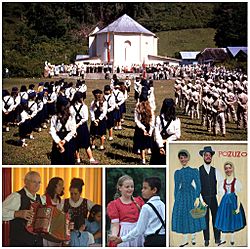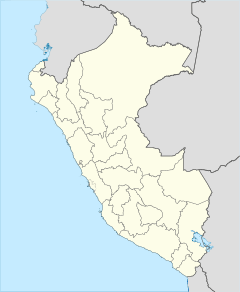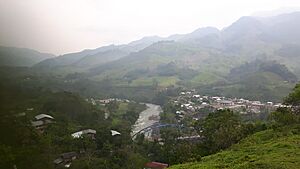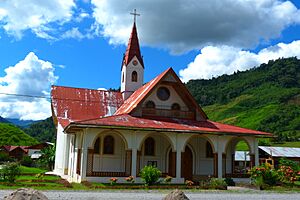Pozuzo facts for kids
Quick facts for kids
Pozuzo
|
||
|---|---|---|
|
German heritage of Pozuzo
|
||
|
||
| Country | ||
| Region | Pasco | |
| Province | Oxapampa | |
| District | Pozuzo District | |
| Founded | 1859 | |
| Elevation | 739 m (2,425 ft) | |
| Population
(2017)
|
||
| • Total | 1,366 | |
| Time zone | UTC−5 (PET) | |
Pozuzo is a village and district in Peru. It is located in the Oxapampa Province within the Pasco Region. The village sits about 739 metres (2,425 ft) above sea level. It is near the Huancabamba River, which changes its name to the Pozuzo River as it flows past the village. In 2017, about 1,366 people lived in Pozuzo.
Pozuzo was started in 1859 by people who moved there from Austria and Germany. You can still see parts of their German culture and building styles today. For a long time, Pozuzo was hard to reach. But in 1976, a road was finished. This road connected the village to the town of Oxapampa, which is about 80 kilometres (50 mi) north.
Contents
Pozuzo's Past: A Look at Its History
Early Settlements and Rebellions
In 1712, Franciscan missionaries created a mission in Pozuzo. However, this settlement was later abandoned or destroyed. This happened in the 1740s or 1750s during the Atahualpa Rebellion. This rebellion was led by the Asháninka people, who lived in the area. Around 1790, the settlement was rebuilt. A bridge was also built across the Pozuzo River.
When explorer William Smyth visited Pozuzo in 1828, the Franciscans had left. Only one Asháninka family lived there. Other local farmers grew crops like coca, sugar cane, squash, and cassava (yuca) nearby. Smyth said the path to Pozuzo from the Andes mountains was narrow and dangerous.
German and Austrian Settlers Arrive
In the 1850s, Peruvian President Ramón Castilla had a big idea. He wanted to build a railroad from Lima, the capital city. It would cross the Andes Mountains and reach the rivers of the Amazon Basin. Part of his plan was to bring German and Austrian Catholics to live there. These areas were mostly home to indigenous people at the time.
In 1855, President Castilla signed a deal. He worked with a German traveler named Kuno Damian von Schütz-Holzhausen. Schütz-Holzhausen was asked to find 10,000 Germans and Austrians. They would move to Peru and start new towns on the eastern side of the Andes. The Peruvian government agreed to pay for their trip from Europe to Peru. They would also pay for their travel to Pozuzo and other settlement areas. Once they arrived in Pozuzo, each family would get 40 hectares (99 acres) of farmland. Single men would receive 24 hectares (59 acres).
Schütz-Holzhausen went to Germany in 1856 to find settlers. He gathered a group of 302 people. About 200 were from Tyrol (Austria) and 100 were from Moselle and Prussia (Germany). Two Roman Catholic priests were also with them. One of them, José Egg, became a leader for the settlers. Most of these settlers were poor farmers and craftspeople with large families.
They left Antwerp, Belgium, on a ship called the Norton on March 26, 1857. They arrived in Callao, Peru, on August 8, 1857. When they got there, Schütz-Holzhausen found that Peru was not ready for them. The government had not prepared much for their arrival or their journey to Pozuzo.
The settlers had a very difficult trip. They walked and rode mules from the port of Huacho. They crossed the Andes, reaching over 4,700 metres (15,400 ft) high. They went through Cerro de Pasco and Acobamba. They even helped build the road as they went to Pozuzo. The town of Pozuzo was officially started in 1859. Only 172 of the original 302 settlers who left Europe made it. Many had left the group, died, or were killed during the hard journey.
One of the first things the settlers decided was to separate their land. The Prussians settled about 5 kilometres (3.1 mi) south of Pozuzo. They created the village of Prusia. The Tyroleans stayed and built the village of Pozuzo.
Pozuzo was one of the few German settlements in the Amazon region of Peru that survived and grew. By 1889, Pozuzo had 565 people. Most of them were farmers. They grew many crops, but the most important ones to sell were tobacco, coffee, coca, and rice. In 1891, some settlers from Pozuzo founded the town of Oxapampa. This new town quickly grew larger than Pozuzo.
Pozuzo in the 20th and 21st Centuries
In 1928, the town of Villa Rica was founded. It was known for growing coffee. Both Villa Rica and Oxapampa were higher up and had a milder climate than Pozuzo.
Pozuzo was cut off from outside help for over 100 years after it was founded. Until 1975, it took three days to travel by mule trail to Huánuco, the closest medium-sized town. A partly paved road was finally built in 1975.
Today, the German heritage in Pozuzo has mixed with other cultures. People have married others from the Andes and local indigenous groups. In 2005, only about 15 percent of the 4,000 people in Pozuzo district said they had German ancestors. That same year, the town elected its first mayor who was not of German heritage.
Pozuzo has become a popular place for tourists. One resident said in 2023 that before the COVID-19 pandemic, tourists only came on special holidays. Now, they visit every day. The annual Pozuzofest is a celebration like Oktoberfest. It attracts hundreds of visitors, some from Peru's capital, Lima, and others from Austria and Germany.
Pozuzo's Climate
Pozuzo has a tropical climate. This means it has plenty of rain all year round. The weather is affected by its altitude, which makes temperatures a few degrees cooler than other nearby tropical areas. The difference in average temperatures between the warmest and coolest months is very small, only about 1.5 degrees Celsius (3 degrees Fahrenheit). The driest months are June, July, and August, which are winter months in the Southern Hemisphere.
| Climate data for Pozuzo, elevation 746 m (2,448 ft), (1991–2020) | |||||||||||||
|---|---|---|---|---|---|---|---|---|---|---|---|---|---|
| Month | Jan | Feb | Mar | Apr | May | Jun | Jul | Aug | Sep | Oct | Nov | Dec | Year |
| Mean daily maximum °C (°F) | 28.1 (82.6) |
27.7 (81.9) |
28.2 (82.8) |
28.6 (83.5) |
28.4 (83.1) |
28.3 (82.9) |
28.4 (83.1) |
29.6 (85.3) |
30.2 (86.4) |
29.8 (85.6) |
29.2 (84.6) |
28.2 (82.8) |
28.7 (83.7) |
| Mean daily minimum °C (°F) | 19.9 (67.8) |
19.9 (67.8) |
19.6 (67.3) |
19.4 (66.9) |
19.3 (66.7) |
18.2 (64.8) |
17.7 (63.9) |
17.6 (63.7) |
18.0 (64.4) |
19.1 (66.4) |
19.7 (67.5) |
20.1 (68.2) |
19.0 (66.3) |
| Average precipitation mm (inches) | 296.2 (11.66) |
301.9 (11.89) |
287.9 (11.33) |
206.0 (8.11) |
122.7 (4.83) |
77.5 (3.05) |
63.1 (2.48) |
69.0 (2.72) |
101.8 (4.01) |
186.3 (7.33) |
216.2 (8.51) |
329.1 (12.96) |
2,257.7 (88.88) |
| Source: National Meteorology and Hydrology Service of Peru | |||||||||||||
See also
 In Spanish: Pozuzo para niños
In Spanish: Pozuzo para niños






